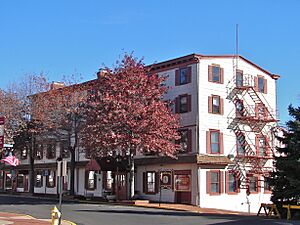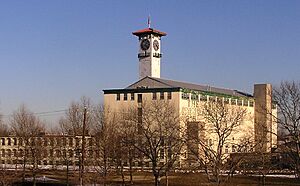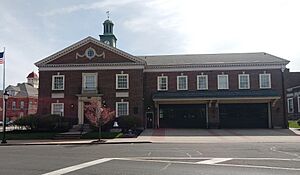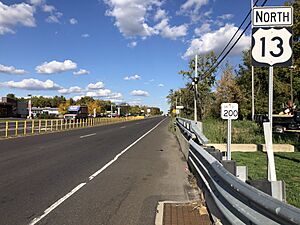Bristol, Pennsylvania facts for kids
Quick facts for kids
Bristol, Pennsylvania
|
||
|---|---|---|

Lions Park on the Delaware River in Bristol, 2010
|
||
|
||
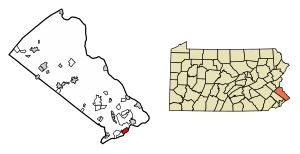
Location of Bristol Borough in Bucks County, Pennsylvania
|
||
| Country | United States | |
| State | Pennsylvania | |
| County | Bucks | |
| Settled | 1681 | |
| Area | ||
| • Total | 1.96 sq mi (5.07 km2) | |
| • Land | 1.70 sq mi (4.40 km2) | |
| • Water | 0.26 sq mi (0.67 km2) | |
| Elevation | 20 ft (6 m) | |
| Population
(2020)
|
||
| • Total | 9,861 | |
| • Density | 5,807.42/sq mi (2,242.41/km2) | |
| Time zone | UTC-5 (Eastern (EST)) | |
| • Summer (DST) | UTC-4 (EDT) | |
| ZIP Code |
19007
|
|
| Area codes | 215, 267, and 445 | |
| FIPS code | 42-08760 | |
|
Pennsylvania Historical Marker
|
||
| Designated: | January 13, 1949 | |
Bristol is a small town, called a borough, in Bucks County, Pennsylvania. It is located about 23 miles (37 km) northeast of Philadelphia. Bristol sits right across the Delaware River from Burlington, New Jersey.
This town was first settled in 1681 and became an official borough in 1720. After 1834, Bristol became very important for America's growth. It was the end point of the Delaware Canal. This canal helped bring special coal from other areas to Philadelphia. The canal also connected Bristol to other states like New Jersey and New York. This helped the town trade goods and connect with bigger cities like New York City.
Bristol is one of the oldest boroughs in Pennsylvania. Its original town rules are still used today. In 2010, about 9,726 people lived here. The current mayor is Joseph A. Saxton. You can get to Bristol by train using SEPTA's Trenton Line.
Bristol is about 70.9 miles (114.1 km) southeast of Allentown. It is also about 22.4 miles (36.0 km) northeast of Philadelphia.
Contents
History of Bristol
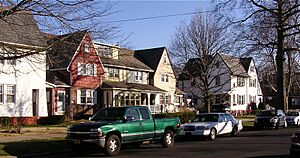
How Bristol Started
Samuel Clift started the Borough of Bristol. He received land from Edmund Andros, who was the governor of New York. This happened in 1681. Samuel Clift had to run a ferry service across the Delaware River to Burlington, New Jersey. He also had to run a public inn, which later became known as the George II.
Bristol Borough was named after Bristol, England. It was first used as a port and dock for ships. The town has many old and restored houses along Radcliffe and Mill streets. In 1697, a town was planned for this spot. Bristol became an official borough in 1702.
Until 1725, Bristol Borough was the main town for Bucks County.
Bristol's Growth and Industry
From its early days, Bristol was a center for making things. There were textile mills, metal factories, and other types of manufacturing. When the Delaware Canal was built, Bristol became a key place. It connected barges carrying coal from Easton to Philadelphia. Bristol was chosen because it already had good shipping links to other parts of Philadelphia. It also had regular ferry services to New Jersey from 1681 until 1931. John Fitch even started the first steamboat ferry service here. It could carry up to 30 passengers.
The canal helped Bristol become a major transportation hub. Later, the Pennsylvania Railroad also connected to the town. This made Bristol an even better place for industries to set up.
By the 1880s, Bristol Borough had many factories. These included companies that made wallpaper and carpets.
Bristol in the World Wars
During World War I, Bristol's docks were big enough for a shipyard. This shipyard built many merchant ships. In 1917, Averell Harriman started the Merchant Shipbuilding Corporation in Bristol. They built 40 cargo ships for the war effort. A new neighborhood called Harriman, Pennsylvania grew around the shipyards. Many of those houses are still used today. In 1922, Harriman became part of Bristol Borough.
Most of the ships were finished too late for World War I. After the war, the shipyard land was used for other things. Between the two world wars, parts of the shipyard were used to build amphibious planes. These "flying boats" were important for long-distance air travel. During World War II, the old shipyards were again used to build airplanes.
Modern Bristol
In 1961, Bristol became famous because of a song called "Bristol Stomp" by The Dovells. The song was very popular and is still played at local events.
In the 1990s, the old shipbuilding site was chosen for a big project. It was called the Riverfront North Project. This project built new homes and created a park. The park has four monuments that celebrate the town's past.
Today, many old buildings and parts of the shipyard are preserved. They are part of the Bristol Historic District and the Bristol Industrial Historic District. Bristol also has many festivals that celebrate its diverse cultures.
Some important historic places in Bristol include the Delaware Division of the Pennsylvania Canal and the Grundy Mill Complex. These sites are listed on the National Register of Historic Places.
In March 2023, there was an equipment issue at a chemical plant in Bristol. This caused a chemical spill in the Delaware River.
People of Bristol
| Historical population | |||
|---|---|---|---|
| Census | Pop. | %± | |
| 1800 | 511 | — | |
| 1810 | 628 | 22.9% | |
| 1820 | 908 | 44.6% | |
| 1830 | 1,262 | 39.0% | |
| 1840 | 1,438 | 13.9% | |
| 1850 | 2,570 | 78.7% | |
| 1860 | 3,314 | 28.9% | |
| 1870 | 3,269 | −1.4% | |
| 1880 | 5,273 | 61.3% | |
| 1890 | 6,553 | 24.3% | |
| 1900 | 7,104 | 8.4% | |
| 1910 | 9,256 | 30.3% | |
| 1920 | 10,273 | 11.0% | |
| 1930 | 11,799 | 14.9% | |
| 1940 | 11,895 | 0.8% | |
| 1950 | 12,710 | 6.9% | |
| 1960 | 12,364 | −2.7% | |
| 1970 | 12,085 | −2.3% | |
| 1980 | 10,867 | −10.1% | |
| 1990 | 10,405 | −4.3% | |
| 2000 | 9,923 | −4.6% | |
| 2010 | 9,726 | −2.0% | |
| 2020 | 9,861 | 1.4% | |
| Sources: | |||
In 2020, the population of Bristol was 9,861 people. The population has changed over the years, growing a lot in the early 1900s.
In 2014, about 69.2% of the people were Non-Hispanic White. About 16.4% were Black or African American. About 15.0% of the population had Hispanic or Latino family backgrounds. There are 661 veterans living in Bristol Borough.
Geography of Bristol
Bristol Borough is located at coordinates 40°6′12″N 74°51′5″W. The U.S. Census Bureau says the borough covers about 1.9 square miles (5.0 km2) in total. Most of this area, about 1.7 square miles (4.4 km2), is land. The rest, about 0.2 square miles (0.67 km2), is water.
Education in Bristol
The Bristol Borough School District has two public schools. They are Warren Snyder-John Girotti Elementary School (for grades K-6) and Bristol High School (for grades 7-12).
You can also find other schools in Bristol. St. Mark Church has a Roman Catholic parish school for grades K-8. Conwell-Egan Roman Catholic School in Fairless Hills, Pennsylvania offers private schooling for grades 9-12. For higher education, Bristol Borough has Pennco Tech.
Climate in Bristol
Bristol has a humid subtropical climate. This means it has hot, humid summers and cool winters. The average temperature is above 32°F (0°C) all year. Summers can be very hot, sometimes feeling over 110°F (43°C) with the humidity. The hottest day recorded was 103.1°F (39.5°C) on July 6, 2010.
Winters can be cold, with temperatures sometimes dropping below 5°F (-15°C). The coldest day recorded was -5.8°F (-21.0°C) on January 22, 1984. Bristol usually gets between 24 and 30 inches (61 and 76 cm) of snow each year. Big snowstorms happen every few years.
| Climate data for Bristol. Elevation: 20 feet (6 m). 1981-2010 Averages (1981-2018 Records). | |||||||||||||
|---|---|---|---|---|---|---|---|---|---|---|---|---|---|
| Month | Jan | Feb | Mar | Apr | May | Jun | Jul | Aug | Sep | Oct | Nov | Dec | Year |
| Record high °F (°C) | 71.9 (22.2) |
77.9 (25.5) |
87.8 (31.0) |
94.9 (34.9) |
96.1 (35.6) |
97.3 (36.3) |
103.1 (39.5) |
101.1 (38.4) |
99.0 (37.2) |
89.1 (31.7) |
81.7 (27.6) |
76.1 (24.5) |
103.1 (39.5) |
| Mean daily maximum °F (°C) | 40.8 (4.9) |
44.0 (6.7) |
52.0 (11.1) |
64.0 (17.8) |
73.5 (23.1) |
82.7 (28.2) |
86.8 (30.4) |
85.2 (29.6) |
78.5 (25.8) |
67.2 (19.6) |
56.4 (13.6) |
45.2 (7.3) |
64.8 (18.2) |
| Daily mean °F (°C) | 32.6 (0.3) |
35.0 (1.7) |
42.2 (5.7) |
52.9 (11.6) |
62.1 (16.7) |
71.6 (22.0) |
76.2 (24.6) |
74.8 (23.8) |
67.7 (19.8) |
56.3 (13.5) |
46.7 (8.2) |
36.9 (2.7) |
54.7 (12.6) |
| Mean daily minimum °F (°C) | 24.3 (−4.3) |
26.0 (−3.3) |
32.5 (0.3) |
41.7 (5.4) |
50.8 (10.4) |
60.6 (15.9) |
65.6 (18.7) |
64.3 (17.9) |
57.0 (13.9) |
45.3 (7.4) |
37.0 (2.8) |
28.6 (−1.9) |
44.6 (7.0) |
| Record low °F (°C) | −9.1 (−22.8) |
−2.4 (−19.1) |
4.4 (−15.3) |
18.1 (−7.7) |
32.8 (0.4) |
42.1 (5.6) |
48.3 (9.1) |
43.1 (6.2) |
36.7 (2.6) |
25.6 (−3.6) |
12.6 (−10.8) |
0.5 (−17.5) |
−9.1 (−22.8) |
| Average precipitation inches (mm) | 3.60 (91) |
2.71 (69) |
4.29 (109) |
3.83 (97) |
4.18 (106) |
4.18 (106) |
4.97 (126) |
4.37 (111) |
3.99 (101) |
3.70 (94) |
3.40 (86) |
3.90 (99) |
47.12 (1,197) |
| Average relative humidity (%) | 65.2 | 61.8 | 58.1 | 57.3 | 62.2 | 65.7 | 66.4 | 68.4 | 69.3 | 68.3 | 66.7 | 66.8 | 64.7 |
| Average dew point °F (°C) | 22.2 (−5.4) |
23.2 (−4.9) |
28.5 (−1.9) |
38.2 (3.4) |
49.0 (9.4) |
59.5 (15.3) |
64.2 (17.9) |
63.7 (17.6) |
57.3 (14.1) |
46.0 (7.8) |
36.2 (2.3) |
26.9 (−2.8) |
43.0 (6.1) |
| Source: PRISM Climate Group | |||||||||||||
Getting Around Bristol
Bristol has many public roads. Some are kept up by the state, and others by the borough itself.
U.S. Route 13 goes through Bristol. It connects to Philadelphia in the southwest and Trenton, New Jersey in the northeast. This route also links to the Pennsylvania Turnpike. Pennsylvania Route 413 runs along the west side of Bristol. It goes north towards Langhorne and south to the Burlington-Bristol Bridge to Burlington, New Jersey.
The Bristol train station is served by SEPTA Regional Rail. This train line goes between Center City Philadelphia and Trenton. While Amtrak trains pass through Bristol, they don't stop here. The closest Amtrak station is in Trenton. SEPTA also offers bus service in Bristol. There's also a special shuttle called the Bristol Rushbus for people going to certain businesses.
Nature in Bristol
Bristol's natural plants are mostly Oak trees. The area is part of an Eastern Hardwood Forest. The weather here allows plants to start blooming around April 7. The leaves usually change color in the fall around November 4.
Famous People from Bristol
- Poul Anderson, a writer of science fiction stories
- Daniel W. Bursch, an astronaut
- John Thompson Dorrance, a chemist who invented condensed soup
- Ileen Getz, an actress from 3rd Rock from the Sun
- Joseph R. Grundy, a textile maker and U.S. Senator
- Lauren Holly, an actress
- Jeff Manto, a professional baseball player
- Joe McEwing, a professional baseball player
- Joseph McIlvaine, a U.S. Senator
- Mike Missanelli, a sports radio personality from Philadelphia
- Charlie Saxton, an actor
- Will Thomas, a novelist
- Todd Weiner, a professional football player
See also
 In Spanish: Bristol (Pensilvania) para niños
In Spanish: Bristol (Pensilvania) para niños





